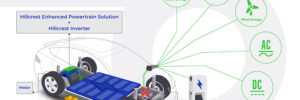Hillcrest Energy Technologies, an inverter and control system company, has released a white paper describing the advantages of its soft switching technology. Hillcrest’s soft switching technology uses high switching frequency and is designed for EV traction inverters.
In the white paper, authors from Hillcrest and Systematec write: “Simulation and experimental results have shown that higher switching frequencies indeed reduce DC-link capacitor ripple current.”
“Ripple current reduction can also result in volume, weight and cost reductions, as fewer parallel capacitors are needed to meet manufacturer ripple limits,” the authors write. “Moreover, the DC-link capacitor size is inversely proportional to switching frequency. As switching frequency increases, the required capacitance decreases. Capacitor volume is proportional to capacitance; therefore, with increased switching frequency, higher power density and lower cost can be achieved.”
“Capacitance for a typical EV traction inverter today is between 600 micro farads and 1 millifarad, while the commercial prototype design of the Hillcrest traction inverter contemplates one-fifth to one-tenth of the capacitance,” says Hillcrest CTO Ari Berger. “Such a significant reduction in capacitor and inverter size and increase in power density, coupled with improved power quality and system reliability, has the potential to disrupt power inverter designs across the automotive space.”
“The company continues validating its technology,” says Hillcrest. “This is the first in a series of anticipated reports demonstrating the value of Hillcrest’s high-efficiency inverter technology from various technical and sub-system aspects.”
Source: Hillcrest
Source: Electric Vehicles Magazine


 Bosch on Wednesday announced a $200 million investment to build hydrogen fuel-cell stacks for Class 8 semi trucks at its Anderson, South Carolina, facility. Production is scheduled to start in 2026, and work has already begun on upgrades that include adding an estimated 147,000 square feet of floor space for fuel-cell manufacturing and related…
Bosch on Wednesday announced a $200 million investment to build hydrogen fuel-cell stacks for Class 8 semi trucks at its Anderson, South Carolina, facility. Production is scheduled to start in 2026, and work has already begun on upgrades that include adding an estimated 147,000 square feet of floor space for fuel-cell manufacturing and related…
